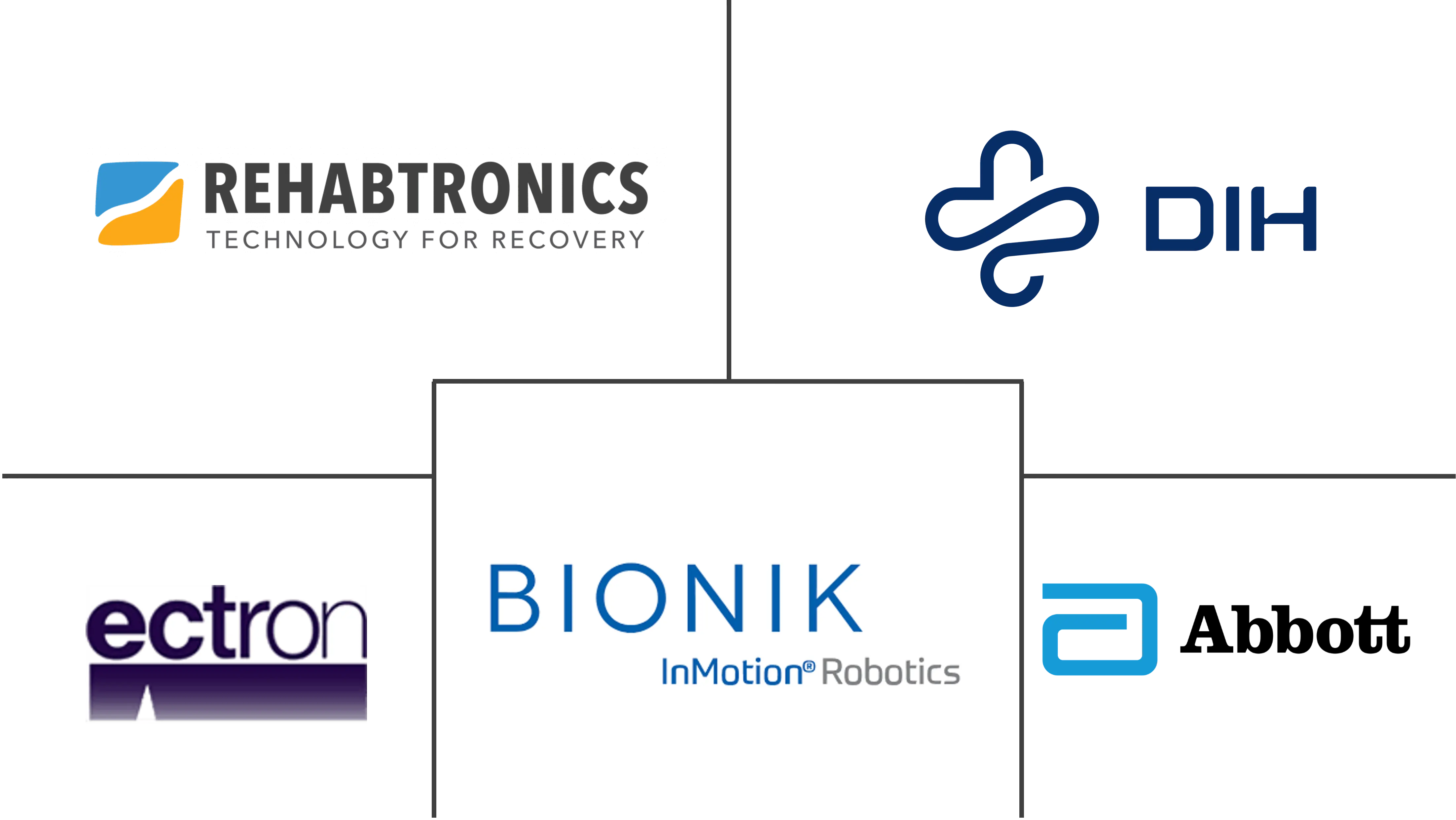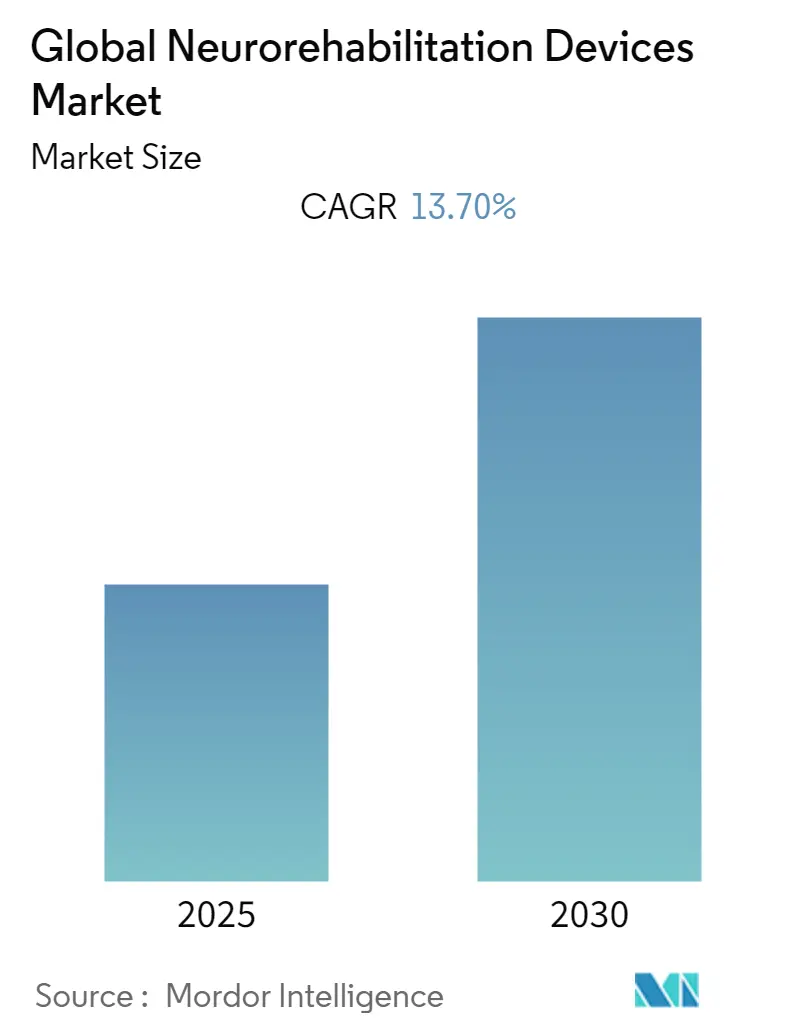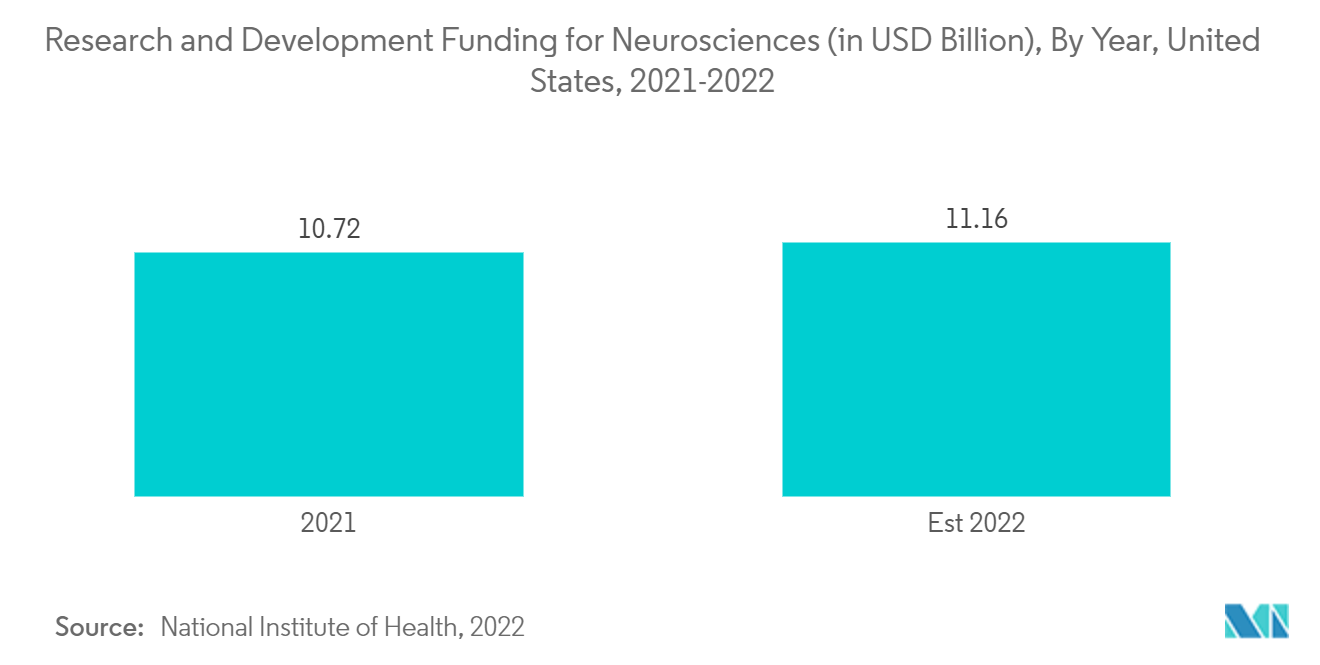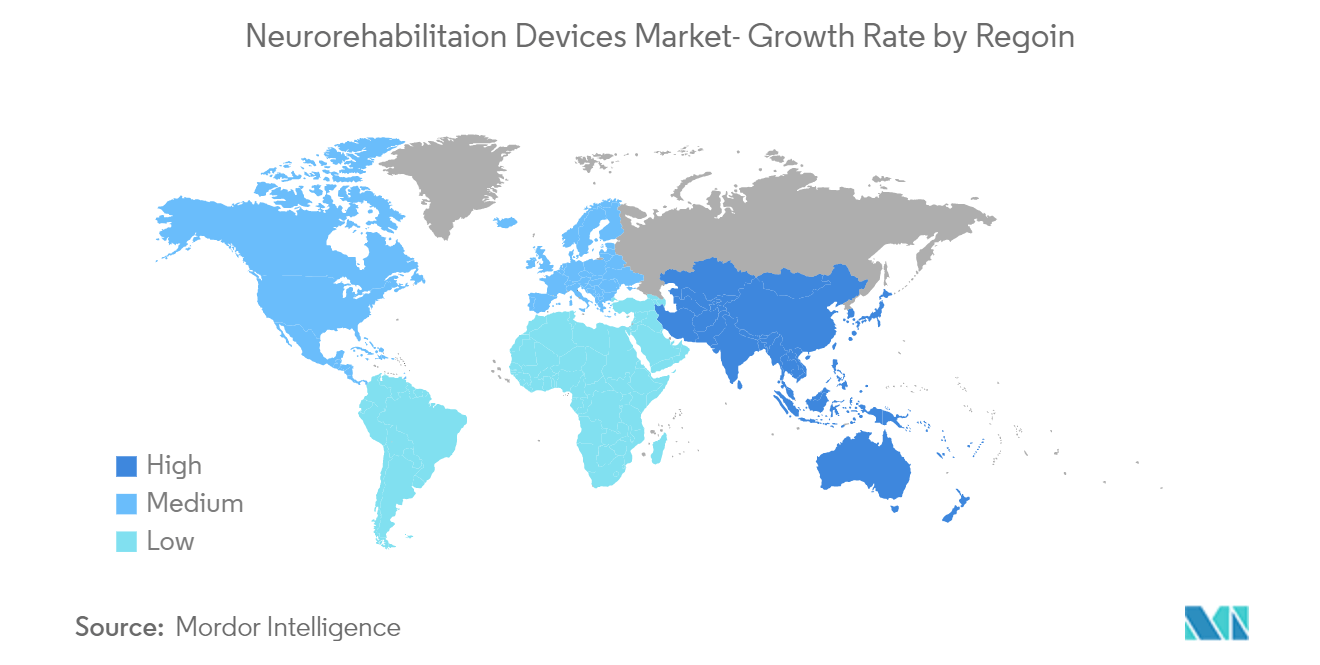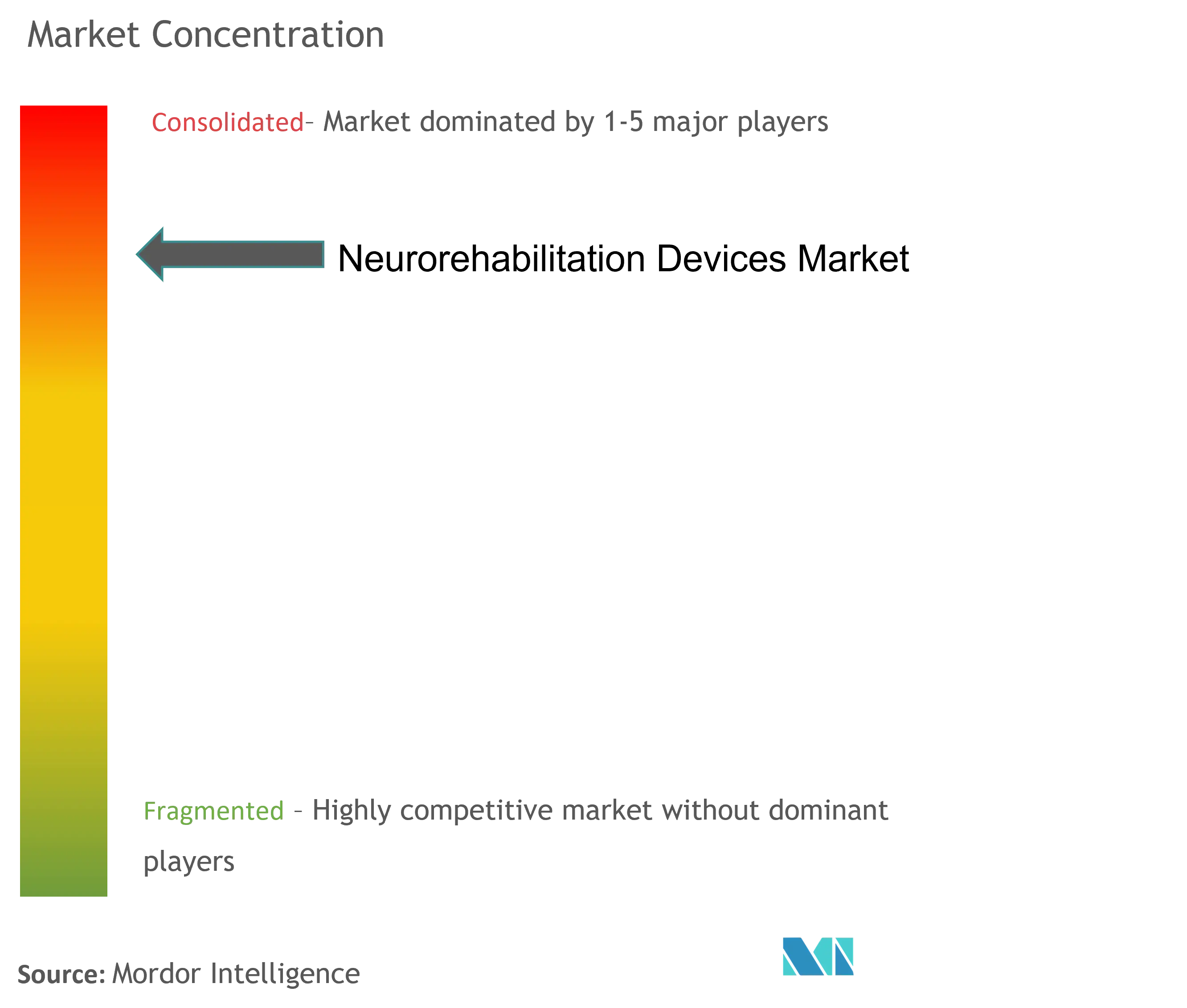Neurorehabilitation Devices Market Analysis
The Global Neurorehabilitation Devices Market is expected to register a CAGR of 13.7% during the forecast period.
COVID-19 has significantly impacted the growth of the neurorehabilitation market owing to factors such as delayed consultations and therapies. For instance, as per the article published in January 2022 in PubMed, during the COVID-19 pandemic, different organizational models were implemented in neurorehabilitation, which had an impact on the duration of treatments, the physical and mental health of healthcare professionals, and the workload of caregivers. Furthermore, according to the study published in October 2021, telerehabilitation was perceived as a key innovation and an effective strategy to combat the pandemic and lower the worldwide handicap load. It also reported that the pandemic scenario presented an opportunity to optimize and scale up health-related technology advancements to tackle the rising burden of neurological impairment in LMICs. Since the COVID-19 restrictions were lifted, the neurorehabilitation devices market is anticipated to witness growth due to the rise in the prevalence of neurological disorders and technological advances in neurorehabilitation devices.
Factors such as the increase in the prevalence of neurological disorders and the surge in neurorehabilitation devices with technological advances. For instance, according to the "World Alzheimer Report 2021," published in September 2021, over 55 million people worldwide live with dementia. This is forecasted to reach 78 million by 2030. The increasing burden of Alzheimer's disease globally surges the demand for neurorehabilitation devices, thereby leading to the growth of the studied market. In addition, approvals for neurorehabilitation devices by international regulatory agencies also contribute to the market's growth over the forecast period. For instance, in April 2021, the United States Food and Drug Administration granted marketing approval for the IpsiHand Upper Extremity Rehabilitation System (IpsiHand System), a brain-computer interface (BCI) device that assists in rehabilitation for stroke patients with upper extremity (hand, wrist, and arm) disabilities. Furthermore, in August 2022, Neurofenix, a health tech startup with roots in the UK, picked up a capital investment of EUR 7 million to build out its product line and kickstart clinical trials in the US. The startup is using a ground-breaking, patient-centric approach to at-home rehabilitation and recovery that is proving to be more supportive and engaging.
Therefore, the rising prevalence of neurological disorders, the growing geriatric population, and technological advancements in neurorehabilitation devices are the key driving factors for the market's growth. However, the high cost of neurorehabilitation devices may hinder market growth over the forecast period.
Neurorehabilitation Devices Market Trends
Neuro-Robotic Devices Segment is Expected to Hold a Major Market Share in the Neurorehabilitation Devices Market
The neuro-robotic devices segment projects significant growth in the neurorehabilitation devices market. It is anticipated to show a similar trend over the forecast period owing to the increasing burden of neurological diseases, technological advancements in robotics, and their combination with neuroscience, coupled with the launch of newer products. Neuro-robotic devices combined with neuroscience and rehabilitation are the new methods for treating neurological disorders, which provide different ways of treatment depending on the specific function to be restored. Robotic devices for neurorehabilitation can be divided into two main categories based on the different types of physical human-robot interactions, such as end-effector devices and exoskeletons.
The research studies performed to understand the effectiveness of the robotic approach in neurorehabilitation also contribute to the adoption of devices and thus drive the growth of the segment. For instance, in an article published in September 2022 in Frontiers, the engineering viability, and efficacy of a cable-driven neuro robot is found to be a useful tool to supplement the established physiotherapy regimens and for giving accurate measures of the patient's performance and progress during neurorehabilitation. Thus, the high effectiveness of neurorobotic devices in different studies may lead to increased adoption of these devices, thereby driving the growth of the segment.
Additionally, the establishment of new robotic-assisted neurorehabilitation centers improved the accessibility of neuro-robotic devices and is thus expected to contribute to segment growth. For instance, in December 2021, Sakra World Hospital launched a robotic-assisted neuro-rehabilitation center in Karnataka, India. Furthermore, in April 2021, researchers at ETH Zurich recently found that artificial neural feedback from a sensorized bionic leg can help users and designers of robotic assistive technologies. The scientists conducted their study at the Laboratory for Neuro Engineering, which is part of the Department of Health Sciences and Technology's Institute for Robotics and Intelligent Systems at ETH Zurich. They claimed that sensory information could enhance prosthetic users' quality of life and confidence while they go about their daily activities, such as walking on uneven terrain or ascending stairs.
Thus, the rising prevalence of neurological disorders, the benefits associated with neuro-robotic devices, the establishment of robotic-assisted neurorehabilitation centers, and technological advancements are the key driving factors in the neuro-robotic devices segment.
North America is Expected to Hold a Significant Share in the Market and Expected to do Same in the Forecast Period
North America is expected to hold a significant market share in the global neurorehabilitation devices market due to the growing incidences of stroke, Alzheimer's, and Parkinson's disease, the growing geriatric population, and technological advancements in neurorehabilitation devices in this region. For instance, according to the Alzheimer's Association's 2022 update, an estimated 6.5 million Americans aged 65 and older will live with Alzheimer's in 2022. Seventy-three percent are 75 or older. By 2050, this number is projected to rise to nearly 13 million.
Furthermore, according to the C.D.C.'s May 2022 update, about 795,000 people experience a new or recurrent type of stroke every year. As per the epidemiology data, approximately 87% of strokes in the United States are ischemic. The rise in ischemic stroke will lead to increased neurorehabilitation device adoption in this region, thereby driving the growth of this market in North America.
Rising initiatives from the key players to increase awareness and the growing adoption of neurorehabilitation are further expected to drive the growth of this market in the United States during the forecast period. For instance, in September 2021, Evolution Devices launched its EvoWalk Platform pilot program for the rehabilitation of walking for those living with neurologically based partial walking paralysis. The company's approach combines remote physical therapy (P.T.) with its EvoWalk smart stimulation device to help patients avoid falls and get instinctual movement back. In addition, in December 2021, the Nebraska Chapter of the Fraternal Order of Eagles ("F.O.E."), an international non-profit community organization, purchased two EksoNR devices on behalf of local Nebraska inpatient rehabilitation facilities. Therefore, the rising adoption of these neurorehabilitation devices also drives market growth.
Thus, due to the rise in the prevalence of neurological disorders, increasing awareness regarding the benefits of neurorehabilitation devices, and the presence of well-established healthcare infrastructure, it is anticipated that North America will witness significant growth in the overall market over the forecast period.
Neurorehabilitation Devices Industry Overview
The neurorehabilitation devices market is consolidated and consists of a few major players. In terms of market share, a few major players dominate the market. Some companies currently dominating the market are Hocoma AG, Bionik Labs, Abbott Laboratories (St. Jude Medical Inc.), Electron Ltd., MagVenture A/S, Helius Medical Technologies, Ekso Bionics, Rehabtronics Inc., and Rehab-Robotics Company Limited.
Neurorehabilitation Devices Market Leaders
-
Bionik Labs
-
Ectron Ltd
-
REHABTRONICS INC.
-
DIH International Limited (Hocoma AG)
-
Abbott Laboratories (St. Jude Medical Inc.)
- *Disclaimer: Major Players sorted in no particular order
Neurorehabilitation Devices Market News
- April 2022: Alliance Equiphoria sponsored a clinical trial under the title "Neurorehabilitation Through Hippotherapy of a Brain Stroke (HippoPostCVA)" to evaluate and analyze the effect of a hippotherapy program of several cycles delivered during 22 weeks in total on the functional and global evolution of post-stroke patients (with a score of Ranking 3 at inclusion) during the outpatient rehabilitation phase.
- February 2022: MindMaze, a pioneer in the multibillion-dollar digital neurotherapeutics market, secured a USD 105 million financing round to accelerate its global commercial growth plans, supercharge ongoing research and development, and consolidate the clinical development pipeline of its industry-defining digital therapeutic solutions for a wide spectrum of neurological diseases.
Neurorehabilitation Devices Industry Segmentation
As per the scope of the report, neurorehabilitation devices help improve function, reduce symptoms, and improve the well-being of people with diseases such as trauma or nervous system disorders. Some of the conditions that may benefit from neurological rehabilitation may include vascular disorders (such as ischemic and hemorrhagic strokes), neurological infectious diseases (such as meningitis, encephalitis, polio, and brain abscesses), trauma, structural or neuromuscular disorders, functional disorders (such as headache, seizure disorder, dizziness, and neuralgia), and neurodegenerative disorders (such as Parkinson disease, multiple sclerosis, amyotrophic lateral sclerosis (ALS), Alzheimer disease, and Huntington chorea). The Neurorehabilitation Devices Market is Segmented by Product Type (Neuro-Robotic Devices, Wearable Devices, Non-Invasive Stimulators, and Brain-Computer Interfaces), End-User (Hospitals/Clinics, Cognitive Care Centers, and Others), and Geography (North America, Europe, Asia-Pacific, Middle East and Africa, and South America). The market report also covers the estimated market sizes and trends for 17 countries across major global regions. The report offers the value (USD million) for the above segments.
| By Product Type | Neuro-Robotic Devices | ||
| Wearable Devices | |||
| Non-Invasive Stimulators | |||
| Brain-Computer Interface | |||
| By End-User | Hospitals/Clinics | ||
| Cognitive Care Centers | |||
| Others | |||
| Geography | North America | United States | |
| Canada | |||
| Mexico | |||
| Europe | Germany | ||
| United Kingdom | |||
| France | |||
| Italy | |||
| Spain | |||
| Rest of Europe | |||
| Asia-Pacific | China | ||
| Japan | |||
| India | |||
| Australia | |||
| South Korea | |||
| Rest of Asia-Pacific | |||
| Middle East and Africa | GCC | ||
| South Africa | |||
| Rest of Middle East and Africa | |||
| South America | Brazil | ||
| Argentina | |||
| Rest of South America | |||
Neurorehabilitation Devices Market Research FAQs
What is the current Global Neurorehabilitation Devices Market size?
The Global Neurorehabilitation Devices Market is projected to register a CAGR of 13.7% during the forecast period (2025-2030)
Who are the key players in Global Neurorehabilitation Devices Market?
Bionik Labs, Ectron Ltd, REHABTRONICS INC., DIH International Limited (Hocoma AG) and Abbott Laboratories (St. Jude Medical Inc.) are the major companies operating in the Global Neurorehabilitation Devices Market.
Which is the fastest growing region in Global Neurorehabilitation Devices Market?
Asia Pacific is estimated to grow at the highest CAGR over the forecast period (2025-2030).
Which region has the biggest share in Global Neurorehabilitation Devices Market?
In 2025, the North America accounts for the largest market share in Global Neurorehabilitation Devices Market.
What years does this Global Neurorehabilitation Devices Market cover?
The report covers the Global Neurorehabilitation Devices Market historical market size for years: 2019, 2020, 2021, 2022, 2023 and 2024. The report also forecasts the Global Neurorehabilitation Devices Market size for years: 2025, 2026, 2027, 2028, 2029 and 2030.
Our Best Selling Reports
Neurorehabilitation Devices Industry Report
Statistics for the 2025 Global Neurorehabilitation Devices market share, size and revenue growth rate, created by Mordor Intelligence™ Industry Reports. Global Neurorehabilitation Devices analysis includes a market forecast outlook for 2025 to 2030 and historical overview. Get a sample of this industry analysis as a free report PDF download.

